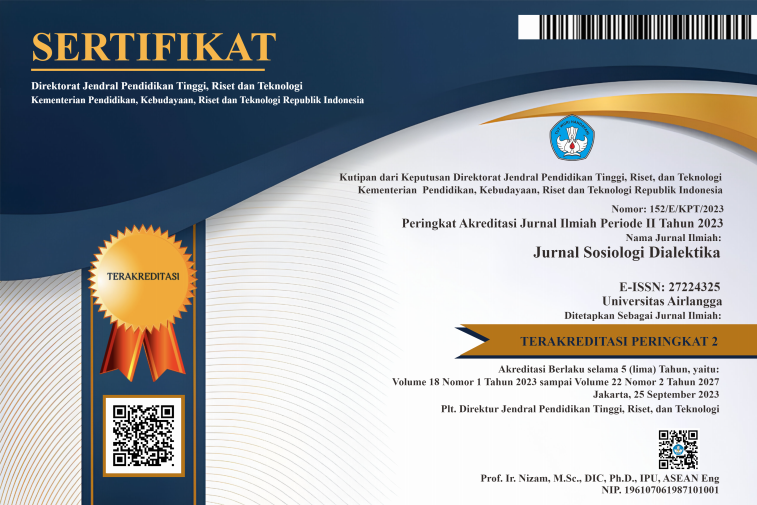The efforts of women victims of domestic violence in maintaining marriages
Downloads
Most of the incidents of domestic violence happen to women as victims, but even though they have accepted acts of violence, women still maintain their marriages. From the existing phenomena, this study reveals the motives of female survivors of former domestic violence victims in maintaining their marriage. This study used qualitative research method. The research subjects were female survivors of former domestic violence victims assisted by WCC Jombang, who were selected based on certain criteria. The results of the study show that the behavior of maintaining the integrity of the marriage is based on the "in order to motive” and the "because motive”. Because the motive for maintaining a marriage is a consideration of the close relationship between a son-in-law and a mother-in-law, a son-in-law and a brother, hindered by the husband's profession, and the consideration of children. In the "in-order-to” motive action to maintain the marriage, the hope is that the family will return to being intact, there will be no violence, no third person, and return to harmony. Furthermore, in order to maintain the marriage, the wife carried out mediation efforts, rearranged the household, asked for protection from the authorities, and assisted the Jombang WCC. This study can be concluded that the existence of in order to motive and action because motive in the wife makes the wife able to maintain the marriage and able to form new knowledge.
Afrianty D (2018) Agents for change: Local women's organizations and domestic violence in Indonesia. Bijdragen tot de taal-, land- en volkenkunde / Journal of the Humanities and Social Sciences of Southeast Asia 174 (1):24-46. https://doi.org/10.1163/22134379-17401024.
Allen M (2011) Violence and voice: Using a feminist constructivist grounded theory to explore women's resistance to abuse. Qualitative Research 11 (1):23-45. https://doi.org/10.1177/1468794110384452.
Annisa S (2019) Sistem patriarki dan stereotip dalam partisipasi perempuan pada science, technology, engineering, and mathematics (STEM). Thesis, Universitas Sumatera Utara, Medan.
Baghi MGR, Mokalu BJ, & Mumu R (2017) Kekerasan dalam rumah-tangga di Kelurahan Paniki Dua Kecamatan Mapanget Kota Manado. Holistik Journal of Social and Culture 20:1–17.
Bassey SA & Bubu NG (2019) Gender inequality in Africa: A re-examination of cultural values. Cogito: Multidisciplinary Research Journal. Rumania: Editura Pro Universitaria.
Ciciek F (1999) Ikhtiar Mengatasi Kekerasan Dalam Rumah Tangga. Jakarta: LKAJ.
Craib I (1984) Teori-Teori Sosial Modern. Jakarta: Raja Grafindo Persada.
Dery I (2021) Give her a slap or two . . . she might change: Negotiating masculinities through intimate partner violence among rural Ghanaian men. Journal of Interpersonal Violence 36 (19-20):9670-9690. https://doi.org/10.1177/0886260519869066.
Dobash RE & Dobash RP (2017) When Women Are Murdered. The Handbook of Homicide. USA: John Wiley & Sons, Inc.
Fakih M (2012) Analisis Gender dan Transformasi Sosial. Yogyakarta: Pustaka Pelajar.
Febriananda LD (2020) Upaya istri korban kekerasan dalam rumah tngga demi mempertahankan keutuhan keluarga (studi di Desa Kedungjati Kecamatan Kabuh Kabupaten Jombang). Thesis, Universitas Islam Negeri Maulana Malik Ibrahim, Malang.
Goode WJ (2007) Sosiologi Keluarga. Jakarta: PT. Bumi Aksara.
Goodman L, Dutton MA, Weinfurt K, & Cook S (2003) The intimate partner violence strategies index. Violence Against Women 9 (2):163-186. https://doi.org/10.1177/1077801202239004.
Graaff K & Heinecken L (2017) Masculinities and gender-based violence in South Africa: A study of a masculinities-focused intervention programme. Journal Development Southern Afrika 34 (5):622-634.
Gravelin CR, Biernat M, & Bucher CE (2019) Blaming the victim of acquaintance rape: Individual, situational, and sociocultural factors. Frontiers in Psychology 9. https://doi.org/ 10.3389/fpsyg.2018.02422.
Hamberger LK, Larsen SE, & Lehrner A (2017) Coercive control in intimate partner violence. Aggression and Violent Behavior 37:1-11.
Hawari D (2006) Marriage Counseling (Konsultasi Perkawinan). Jakarta: Fakultas Kedokteran UI.
Houston C (2014) How feminist theory became (criminal) law: Tracing the path to mandatory criminal intervention in domestic violence cases. Michigan Journal of Gender and Law 21 (2):217-272.
Jeremiah RD, Quinn CR, Alexis JM (2017) Exposing the culture of silence: Inhibiting factors in the prevention, treatment, and mitigation of sexual abuse in the Eastern Caribbean. Child Abuse & Neglect 66:53-63.
Jewkes R & Morrell R (2018) Hegemonic masculinity, violence, and gender equality: Using latent class analysis to investigate the origins and correlates of differences between men. Men and Masculinities 21 (4):547–571.
Johnson BE &Ray W (2016) Family Systems Theory: The Wiley Blackwell Encyclopedia of Family Studies. New York: Wiley-Blackwell Publishing.
Karmen A (2007) Crime Victims: An Introduction to Victimology (6th edition). USA: ThompsonWadsworth.
Komnas Perempuan (2021) Catatan Tahunan Komna Perempuan. Jakarta: Komnas Perempuan.
Kusworo E (2009) Metode Penelitian Komunikasi: Fenomenologi, Konsepsi, Pedoman dan Contoh Penelitiannya. Bandung: Widya Padjajaran.
Leclerc B, Chiu YN, Cale J, & Cook A (2016) Sexual violence against women through the lens of environmental criminology: Toward the accumulation of evidence-based knowledge and crime prevention. European Journal on Criminal Policy and Research 22 (4):593-617.
Manan MA (2018) Kekerasan dalam rumah tangga dalam perspektif sosiologis. Jurnal Legislasi Indonesia 5 (3):9-34.
Mas'udah S, Megasari LA, & Saud S (2021) Women's resistance to domestic violence during COVID-19 pandemic: A study from Indonesia. Jurnal Sosiologi Dialektika 16 (2):163-174. https://doi.org/10.20473/jsd.v16i2.2021.163-174.
Mazibuko NC (2017) Checkmating the mate: Power relations and domestic violence in a South African township. South African Review of Sociology 48 (2):18-31.
Moolman B (2017) Negotiating masculinities and authority through intersecting discourses of tradition and modernity in South Africa. NORMA 12 (1):38-47. https://doi.org/10.1080/18902138.2017.1293398.
Mariana M (2018)Fenomena maraknya kasus kekerasan dalam rumah tangga dilihat dari perspektif sosiologi hukum. Syntax Literate Jurnal Ilmiah Indonesia 3 (3):108-118.
Mshweshwe L (2018) Support for abused rural women in the Eastern Cape: Views of survivors and service providers. Disertation, University of Johannesburg, South Africa.
Mshweshwe L (2020a) Boys transition to manhood; culture, masculinity, and domestic violence. www.youthandpolicy.org/articles/domestic-violence-in-south-africa/.
Mshweshwe L (2020b) Understanding domestic violence: Masculinity, culture, traditions. Heliyon 6 (10). https://doi.org/10.1016/j.heliyon.2020.e05334.
Muhadjir (2005) Negara dan Perempuan. Yogyakarta: CV Adipura.
Mansur MA, Saim, Riyaldi R (2021) Faktor penyebab perselingkuhan suami istri dan upaya penanganannya di KUA Kecamatan Rupat. Jurnal Tahkim 17 (1):62-82.
Mumtazi A (2017) Pandangan sosiologi hukum Islam terhadap istri sebagai pencari nafkah utama (studi kasus di Desa Linggapura Kecamatan Tonjong Kabupaten Brebes). Thesis, Universitas Islam Negeri Sunan Kalijaga, Yogyakarta.
Myers K & Demantas I (2016) Breadwinning and bread-losing: Exploring opportunities to rework manhood. Sociology Compass 10 (12):1119-1130. https://doi.org/10.1111/soc4.12437.
Nadeak DS (2018) Conflict between the in-laws of the woman and the parent mother in the Batak tribe living in the house at Desa Karya Indah Kecamatan Tapung Kabupaten Kampar. JOM FISIP 5 (1):1-15.
Ningrum WTP & Mas'udah S (2021) Family conflicts and the violence of unemployed husbands against their wives acting as the main breadwinner. Jurnal Sosiologi Dialektika 16 (1):76-85. https://doi.org/10.20473/jsd.v16i1.2021.76-85.
Nisa S (2019) Konflik suami istri dalam keluarga selaput kosong. Thesis, Universitas Airlangga, Surabaya.
Nugraha ACW & Rahmi H (2021) Dinamika resiliensi pada istri yang menjadi korban perselingkuhan suami. Jurnal Kajian Ilmiah 21 (1):85-100.
Oktaviani R & Azeharie SS (2020) Penyingkapan diri perempuan penyintas kekerasan seksual. Koneksi 4 (1):98-105.
Dewi IDADP & Hartini N (2017) Dinamika forgiveness pada istri yang mengalami kekerasan dalam rumah tangga (KDRT). INSAN Jurnal Psikologi Dan Kesehatan Mental 2 (1):51-62.
Quek K (2019) Patriarchy. In: Handbook on Gender and Violence. Edward Elgar Publishing.
Rahmah M, Quraisy H, & Risfaisal (2019) Konflik sosial menantu yang tinggal serumah dengan mertua (studi kasus di Desa Lempang Kecamatan Tanete Riaja Kabupaten Barru). Equilibrium Jurnal Pendidikan 7 (2):206-210.
Raho B (2007) Teori Sosiologi Modern. Jakarta: Prestasi Pustakaraya.
Ratele K (2015) Working through resistance in engaging boys and men towards gender equality and progressive masculinities. Culture, Health & Sexuality 17 (sup2):144-158.
Rustiyaningsih T (2018) konflik mertua sebagai hambatan generasi komunikasi lintas budaya. Jurnal Ilmu Komunikasi Andalan 1 (1):1-15.
Samsudin (2016) Sosiologi Keluarga: Studi Perubahan Fungsi Keluarga. Yogyakarta: Pustaka Pelajar.
Santi Y (2015) Peran komunikasi interpersonal dalam menjaga hubungan yang harmonis antara mertua dan menantu perempuan. Jurnal Ilmu Sosial dan Ilmu Politik Universitas Tribhuwana Tunggadewi 4 (3):466-472.
Satiadarma MP (2010) Menyikapi Perselingkuhan. Jakarta: Pustaka Popule.
Schaefer LM, Howell KH, Sheddan HC, Napier TR, Shoemaker HL, & Miller-Graff LE (2019) The road to resilience: Strength and coping among pregnant women exposed to intimate partner violence. Journal of Interpersonal Violence 36 (17-18):8382-8408. https://doi.org/10.1177/0886260519850538.
Schneider D, Harknett K, & McLanahan S (2016) Intimate partner violence in the great recession. Demography 53 (2):471-505.
Singh SK, Vishwakarma D, Sharma SK, & Kashayp GC (2018) A nexus between diversity in women's empowerment and violation of their sexual rights in India: Evidence from National Family Health Surveys. Journal of Women's Health Care 7 (3):1-11. https://doi.org/10.4172/2167-0420.1000430.
Sikweyiya Y, Addo-Lartey AA, Alangea DO, Dako-Gyeke P, Chirwa ED, Coker- Appiah D, Jewkes R (2020) Patriarchy and gender-inequitable attitudes as drivers of intimate partner violence against women in the central region of Ghana. BMC Publ. Health 20 (1). https://doi.org/10.1186/s12889-020-08825-z.
Steven Y & Sukmaningrum E (2018) Pemaafan pada istri dewasa muda yang suaminya pernah berselingkuh. Jurnal Psikologi Ulayat 5 (1):1-27.
Suyanto B &. Sutinah (2007) Metode Penelitian Sosial Berbagai Alternatif Pendekatan. Jakarta: Prenadamedia Group.
Syafe'i I (2015) Subordinasi perempuan dan implikasinya terhadap rumah tangga. Jurnal Studi Keislaman 15 (1):143-166.
Triadi G (2005) Saat Cerai Menjadi Pilihan. Yogyakarta: Dozz Publishing.
WCC Jombang (2020) Data kasus kekerasan terhadap perempuan tahun 2020. [Accessed 21 July 2021]. http://www.wccjombang.org/2020/02/data-kasus-bulan-januari-juni-2020-no.html.
Wirawan IB (2012) Teori-Teori Sosial dalam Tiga Paradigma. Jakarta: Kencana Prenadamedia Group.
Yalley AA & Olutayo MS (2020) Gender, masculinity and policing: An analysis of the implications of police masculinized culture on policing domestic violence in southern Ghana and Lagos, Nigeria. Social Sciences & Humanities Open 2 (1). https://doi.org/10.1016/j.ssaho.2020.100077.
Yeni H (2008) Kekerasan dalam rumah tangga (KDRT): Persoalan privat yang jadi persoalan publik. Jurnal Legislasi Indonesia 5 (3):75-86.
Copyright (c) 2022 Jurnal Sosiologi Dialektika

This work is licensed under a Creative Commons Attribution-NonCommercial-ShareAlike 4.0 International License.
1. Copyright of this journal is possession of Editorial Board and Journal Manager, by the knowledge of author, whilst the moral right of the publication belongs to the author.
2. Legal formal aspect of journal publication accessibility refers to Creative Commons Attribution-NonCommercial-ShareAlike (CC BY-NC-SA), implies that publication can be used for non-commercial purposes in its original form (cannot be modified).
3. Every publications (printed/electronic) are open access for educational purposes, research, and library. Other that the aims mentioned above, editorial board is not responsible for copyright violation.















